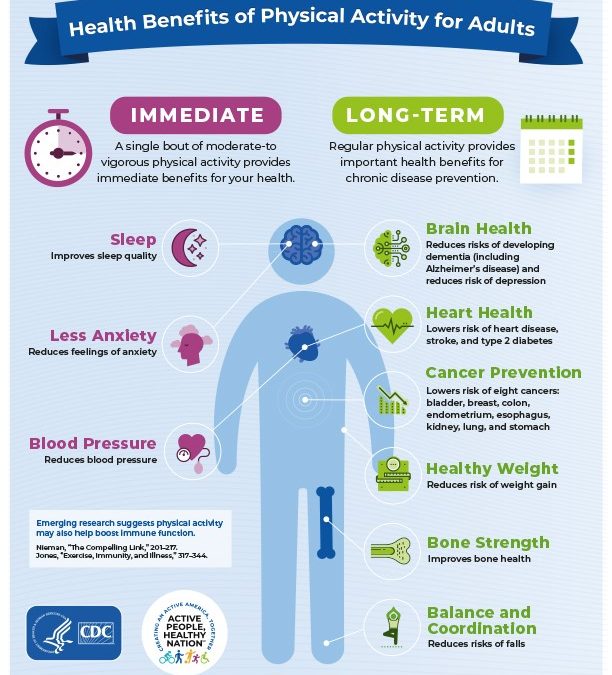
Research & Data Services
February 12-16, 2024
#LoveData24
Wednesday, February 14, 2024 – Blog Post by Tiffany Grant, PhD, CDE
Did you know…
- Prolonged sitting increases risk of spinal, shoulder, carpal tunnel, and leg disorders
- Sitting for more than 3 hours/day increases risk for all-cause mortality deaths
- Sitting too much increases cholesterol and accelerates weight gain
- People who sit most of the day and people who smoke have the same risk of heart attack
Question: What is the single most important thing you can do this very moment for health?
Answer: MOVE!
Regular exercise is one of the most important things you do to improve your health. For those that don’t like the term “exercise”, let’s just use the term “movement” because virtually any movement counts, even those that don’t resonate as “exercise”. Throughout the day, aim to move more and sit less because some activity is better than no activity. Though seemingly small now, it will add up over time to equate to added health benefits.
The CDC recommends 150 – 300 minutes of moderate-intensity physical activity/week or 75 minutes to 150 minutes of vigorous intensity activity/week. These minutes can be broken down into smaller chunks of time, such as 30 minutes/day for 5 days. Your activity can be walking, jogging, running, dancing, biking, mowing the lawn, walking the dog, golf, hiking, or virtually anything that will get you moving.
How do you determine if your movement is considered “moderate” or vigorous?
- Moderate-intensity activity means you’re working hard enough to raise your heart rate and break a sweat. One way to tell if it’s a moderate-intensity aerobic activity is that you’ll be able to talk, but not sing the words to your favorite song.
- Vigorous-intensity activity means you’re breathing hard and fast, and your heart rate has gone up quite a bit. You may use the Talk Test to gauge the intensity of your aerobic physical activity. If you’re being active at a vigorous level, you won’t be able to say more than a few words without pausing for a breath.
- Individuals can also get a more accurate assessment of moderate and vigorous intensity exercise using formulas that consider your age and heart rate. Many activity trackers can assess your heart rate and help you determine whether you have reached your desired intensity. If you do not have an activity tracker, this article gives a great breakdown on how to calculate these for yourself.
The CDC also recommends that individuals undergo strength training exercises for all major muscle groups at least two times a week. 12-15 repetitions of each with enough resistance to tire your muscles out is enough for health and fitness benefits.
Health benefits start immediately after exercising, and even short episodes of physical activity are beneficial. Even better, research shows that just about everyone gains benefits: men and women of all races and ethnicities, young children to older adults, women who are pregnant or postpartum (first year after delivery), people living with a chronic condition or a disability, and people who want to reduce their risk of chronic disease.
Stuck at desk for most of the day? Use this resource to squeeze in movement throughout the day.
Find tips to “Move Your Way”, whether it’s as a family, indoors, during pregnancy, and as you can.
Immediate results from exercise
- Boost your mood
- Sharpen your focus
- Reduce your stress
- Improve your sleep
Long term benefits from exercise
- Lower risk for major conditions such as
- Cardiovascular disease
- Hypertension
- Diabetes
- Cancer
- Stroke
- Boost energy levels
- Control weight
- Strengthen bones
If you are new to exercise or increased movement, no worries. Start slowly and build from there and your body will respond in kind. Once you feel that you have mastered a particular duration or frequency, gradually increase the minutes per session and the number of days/week. It may seem hard in the beginning, but just remember, some movement is better than none. As you commit to making these changes, you will be surprised how well your body adapts. Then you can be proud of the effort you have put into your body and the rewards to your health.

Now, let’s move!
No material on this site is intended to be a substitute for professional medical advice, diagnosis or treatment. Always seek the advice of your physician or other qualified health care provider with any questions you may have regarding a medical condition or treatment and before undertaking a new health care regimen, and never disregard professional medical advice or delay in seeking it because of something you have read on this website.
References
